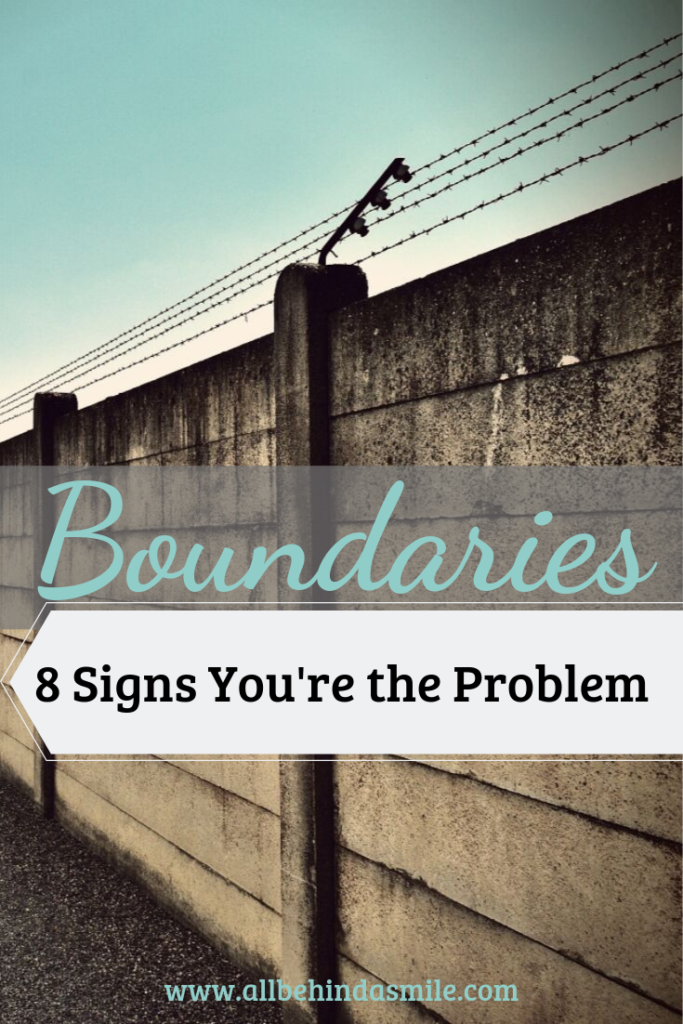With many people, boundary issues fall on one end of the spectrum or the other – either their boundaries are too strong, or too weak.
Interestingly enough, my husband and I each represent a different end of said spectrum. His boundaries are too strong (he would probably disagree). Which, you guessed it – in this case means mine are too weak.
However, it doesn’t have to be this way. Just because one person has strong (or too strong) boundaries doesn’t mean someone else’s have to be weak.

In this case, we are considering if boundary issues in our life are due to ourselves having a lack of (or too strong) boundaries.
Boundaries (or lack of) are a choice!
Think about it for a moment. With a large portion of decisions we make, we are either enforcing a boundary, or allowing a boundary to be ignored.
So, what might boundary issues look like?
In particular, what might it look like if we ourselves have issues with boundaries?
A lack of boundaries (with others) may look like:
- allowing others to get their way, regardless of your own personal wishes
- being “walked all over”
- feeling guilty when you stand up for yourself
- Resenting the other person (when you could have said “no”)
A mild example of lack of boundaries could be: my friend asked me to come over when I have chores to take care of. Initially I tell her I have things to do, but she keeps asking. Instead of telling her no, and doing my chores, I agree and secretly resent her for pressuring me to go with her when I didn’t want to go.
Too strong boundaries with others may look like:
- Your way or “the highway”
- Pressuring/forcing others to follow your wishes regardless of their own
- Rigid, immovable rules regardless of circumstances
- Lack of respect or consideration for other people
A mild example of too strong boundaries may be: a person lives in a setting where they share the backyard with neighbors. Both the person and the neighbor have their own dog, and the dogs do not get along. The neighbor keeps their dog out in the backyard alone often, and to “enforce” their rights to the yard, the person brings their dog out with the other dog without the neighbor’s consent. The neighbor has previously stated that the person could knock on their door and they would bring their dog in.
Do over, anyone?
If proper boundaries were used, both of these situations could look very different.
Let’s start with the situation with the friend wanting to hang out.
One way of handling that situation: my friend asked me to come over when I have chores to take care of. Initially I tell her I have things to do, but she keeps asking. Instead of caving like usual, I explain to her that I feel overwhelmed with everything I need to do, and really need to stay home and do chores instead of going out. She understands, and we agree to hang out tomorrow.
Keep in mind that real life doesn’t necessarily flow so smoothly. If the friend in this situation had boundaries that were too strong (opposite end of the spectrum) this situation could have went very differently. Also, some friends might get upset or angry when you start enforcing your personal boundaries.
Now a do-over with the situation with the neighbor’s dog.
The neighbor a person shares a backyard with keeps his dog out regularly without supervision. The person also has a dog, and the two dogs don’t get along. Due to this, the neighbor has stated that the person can knock on their door when they want to bring their dog out, and thus share the yard. Instead of “enforcing” their rights to the yard by bringing their dog out with the other dog present, the person knocks on the neighbor’s door and nicely asks if they can bring their dog in. The neighbor does so, and thus avoids any fighting between the two dogs. Both dogs are able to have outdoor time and go potty, while remaining safe and boundaries are respectfully established.
Again, in real life this situation may not flow so smoothly. Maybe the neighbor is unwilling to bring their dog in like they claimed – or maybe they get angry. Regardless, there are usually options other than forcing your boundaries on others – respectful options that don’t including allowing people to “walk all over” you.
Are you working on establishing healthy boundaries? Where are you on the spectrum currently?

Christian, wife, “hybrid” mama, I run the site All Behind A Smile to help others like me.


[…] For more help with boundaries and saying “no”, please see Boundary Issues (with 8 Signs You’re the Problem). […]